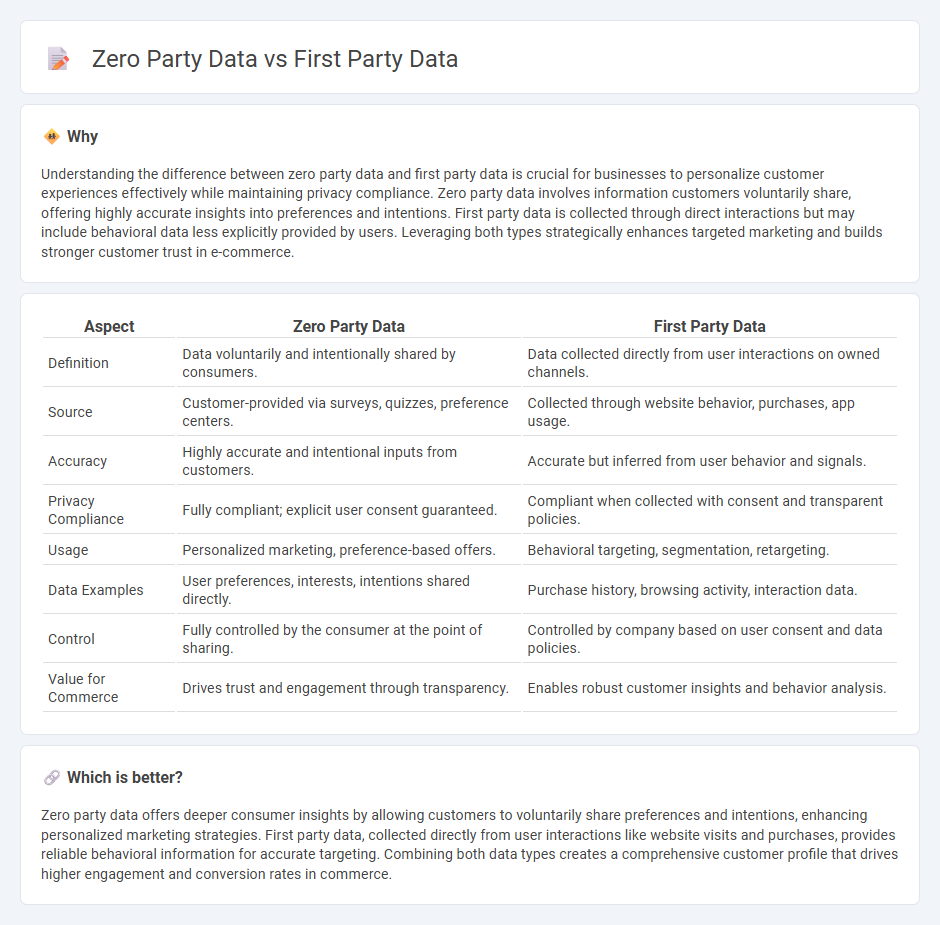
Zero party data refers to information that customers intentionally and proactively share with a brand, such as preferences and feedback, offering precise insights for personalized marketing strategies. First party data, collected directly from user interactions on a website or app, includes behavioral and transactional data critical for understanding customer actions and improving user experience. Explore further to uncover how leveraging these data types can revolutionize commerce strategies and enhance customer engagement.
Why it is important
Understanding the difference between zero party data and first party data is crucial for businesses to personalize customer experiences effectively while maintaining privacy compliance. Zero party data involves information customers voluntarily share, offering highly accurate insights into preferences and intentions. First party data is collected through direct interactions but may include behavioral data less explicitly provided by users. Leveraging both types strategically enhances targeted marketing and builds stronger customer trust in e-commerce.
Comparison Table
| Aspect | Zero Party Data | First Party Data |
|---|---|---|
| Definition | Data voluntarily and intentionally shared by consumers. | Data collected directly from user interactions on owned channels. |
| Source | Customer-provided via surveys, quizzes, preference centers. | Collected through website behavior, purchases, app usage. |
| Accuracy | Highly accurate and intentional inputs from customers. | Accurate but inferred from user behavior and signals. |
| Privacy Compliance | Fully compliant; explicit user consent guaranteed. | Compliant when collected with consent and transparent policies. |
| Usage | Personalized marketing, preference-based offers. | Behavioral targeting, segmentation, retargeting. |
| Data Examples | User preferences, interests, intentions shared directly. | Purchase history, browsing activity, interaction data. |
| Control | Fully controlled by the consumer at the point of sharing. | Controlled by company based on user consent and data policies. |
| Value for Commerce | Drives trust and engagement through transparency. | Enables robust customer insights and behavior analysis. |
Which is better?
Zero party data offers deeper consumer insights by allowing customers to voluntarily share preferences and intentions, enhancing personalized marketing strategies. First party data, collected directly from user interactions like website visits and purchases, provides reliable behavioral information for accurate targeting. Combining both data types creates a comprehensive customer profile that drives higher engagement and conversion rates in commerce.
Connection
Zero party data and first party data are interconnected as both originate directly from consumers, providing businesses with accurate and privacy-compliant insights. Zero party data is explicitly shared by customers through preferences and intentions, enhancing first party data collected from actual behavior on websites or apps. Combining these data types enables personalized commerce strategies that improve customer engagement and increase conversion rates.
Key Terms
Data Ownership
First party data is information a company collects directly from its customers through interactions such as website visits, purchases, or surveys, giving businesses control but within the scope of observed behaviors. Zero party data goes deeper, encompassing information customers intentionally and proactively share, including preferences, intentions, and personal context, providing companies with explicit consent and higher data accuracy. Discover how leveraging data ownership in first party and zero party data can transform your customer engagement strategy.
Data Source
First party data originates directly from user interactions on owned channels such as websites, apps, or CRM systems, providing insights based on observed behaviors and transactions. Zero party data is explicitly and intentionally shared by customers, including preferences, intentions, and personal context, enabling highly personalized marketing strategies. Explore the nuances of these data sources to enhance customer engagement and data-driven decision-making.
Customer Consent
First party data is information a company collects directly from customers through interactions like purchases and website visits, often under established consent frameworks. Zero party data, explicitly shared by customers such as preferences and intentions, offers a higher level of transparency and control, reinforcing trust in data usage practices. Explore the distinctions in customer consent to optimize data strategies effectively.
Source and External Links
What Is First-Party Data (+ Second-Party and Third-Party Data) - First-party data is information a company collects directly from its own audience, such as demographic info, behaviors on websites or apps, CRM data, social media interactions, customer feedback, and purchase history, often gathered through tracking pixels and surveys specific to that business context.
What is first-party data and how does it benefit your marketing - First-party data is obtained directly from customers via interactions on a company's channels like websites or apps, including transactional data and feedback, and it is considered more accurate and trustworthy as customers willingly share it, though collection must comply with privacy laws such as GDPR or CCPA.
What is first-, second-, third- and zero-party data? - First-party data is collected straight from customers through a company's own channels including website pixels and transactions, providing crucial insights that enhance personalized marketing, maintain durable customer connections beyond cookies, and enable targeted cross-sell and upsell strategies.
 dowidth.com
dowidth.com